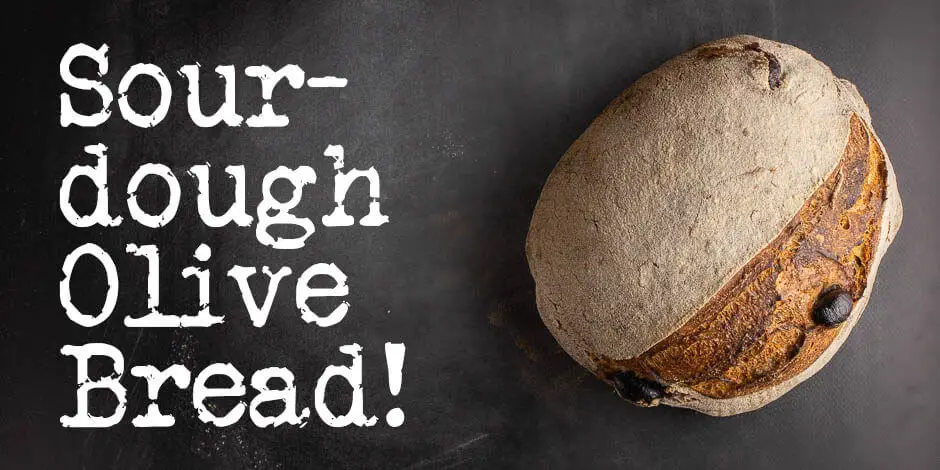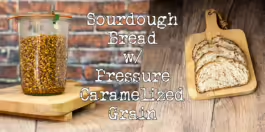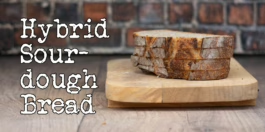For the last year, I’ve been playing and enjoying the game Assassin’s Creed Odyssey which is set in ancient Greece. The countries around the Mediterranean sea, eat a very different diet than we do in the Nordic countries, and that has always fascinated and inspired me. This is my recipe for delicious sourdough olive bread.
The bread has a healthy amount of Kalamata olives and is spiced with dried herbs that grow naturally in the region. We’re using basil, thyme, oregano, and rosemary.
If you are just here for the recipe, you can press the button underneath to be automagically transported to the recipe:
Jump to Recipe Jump to Video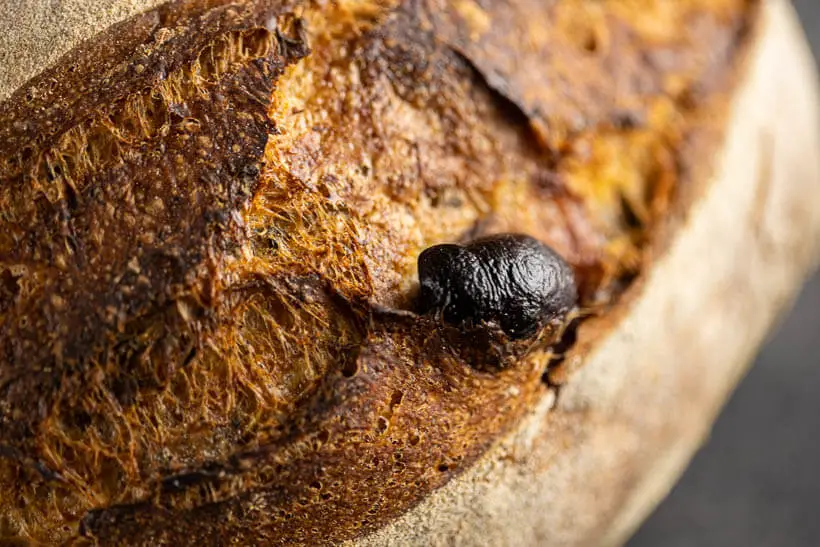
Higher hydration than before
This bread is a step up in hydration from my sourdough bread for beginners which has a hydration of 70%. That bread is a bit more forgiving if you don’t get the gluten all the way, but this higher hydration helps with getting bread that will stay fresh longer.
A breads hydration is the ratio of the total water in regards to the total flour in a percentage
I chose to raise the hydration by five percent. It seems like a good place to start, so this bread is made with 75% hydration.
The formula in this sourdough olive bread recipe
To make this sourdough olive bread recipe you need an active sourdough starter. If you don’t have one you can learn how to make one.
When you look at the table below, you may say that it says that the water is 62.3%, but you said that the hydration is 75%, but you have to remember to add the water and the flour from the levain.
The amount of starter that’s included in the dough is 250g. That means it contains 50g bread flour, 50g whole-grain wheat flour, 50g starter (which is 25g flour and 25g water), and 100g water.
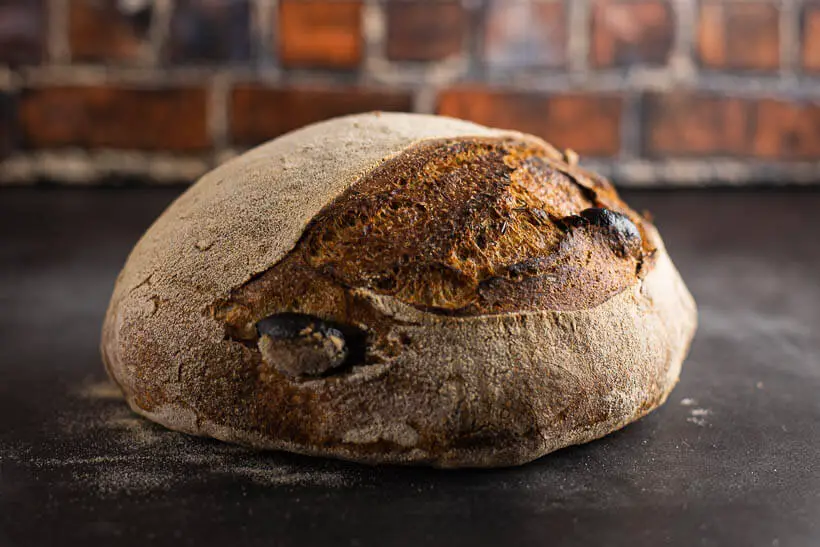
That brings the total flour weight up to 988g (704g + 159g + 50g + 50g + 25g) and the total water weight up to 741g (616g + 100g + 25 g).
Then we just divide the water weight by the flour weight and multiply by 100. Voila. 75%.
If you want to change the hydration, it can be done through my Bread Calculator.
| Weight | Ingredient | Baker's Percentage |
|---|---|---|
| 50g | bread flour | 50% |
| 50g | whole-grain wheat flour | 50% |
| 100g | water | 100% |
| 50g | starter (100% hydration) | 50% |
| Weight | Ingredient | Baker's Percentage |
|---|---|---|
| 704g | bread flour | 81.6% |
| 159g | whole-grain wheat flour | 18.4% |
| 616g | water | 71.4% |
| 21g | salt | 2.4% |
| 250g | olives | 29% |
| 0.5g | basil | ~0.06% |
| 0.3g | thyme | ~0.03% |
| 0.3g | rosemary | ~0.03% |
| 0.3g | oregano | ~0.03% |
What type of olives should I use in this sourdough olive bread recipe?
Culinarily there are three types of olives. They all come from the same tree, but it’s about when they are picked.
They are:
- Green olives – they are picked when the olive fruit has the right size, but before it ripens.
- Half-ripe olives – these olives have started the ripening process. The skin has started changing color, but the flesh is still green. The colors vary from green to several shades between red and brown.
- Black olives – fully ripened olives. Both the skin and the flesh are in the color nuances between brown and black.
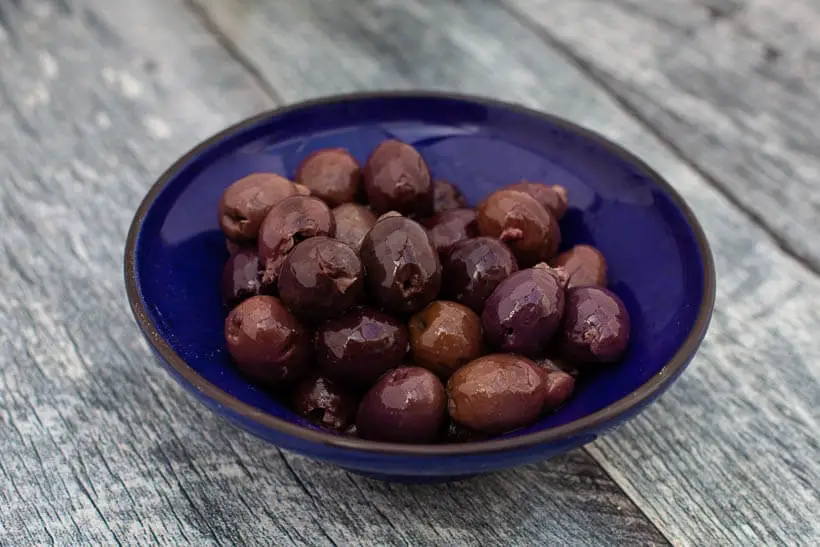
I chose some delicious black Kalamata olives that I brought from a specialty store in Copenhagen called “Stig’s Olives”. The best olives that you can find, it’ll make a difference in the final result.
Baking with steam
To give the bread a great oven spring you will need to bake the bread with steam.
There are several ways to do this:
- Use the steam function of your oven
- Use a pan with a rolled-up towel in the bottom of your oven while baking
- Bake the bread in a dutch oven or combo cooker.
Whatever way you choose to use, do not skip baking with steam. You won’t get the right result, but all of the above methods will give great results.
Conclusion
This sourdough olive bread recipe has relatively high hydration. Not so hard that it is impossible to work with the dough, but you need to know the techniques to get a good result.
The crumb is open and full of delicious olives. The herbs accentuate the Mediterranean vibe and perfectly suit the earthy notes from the olives.
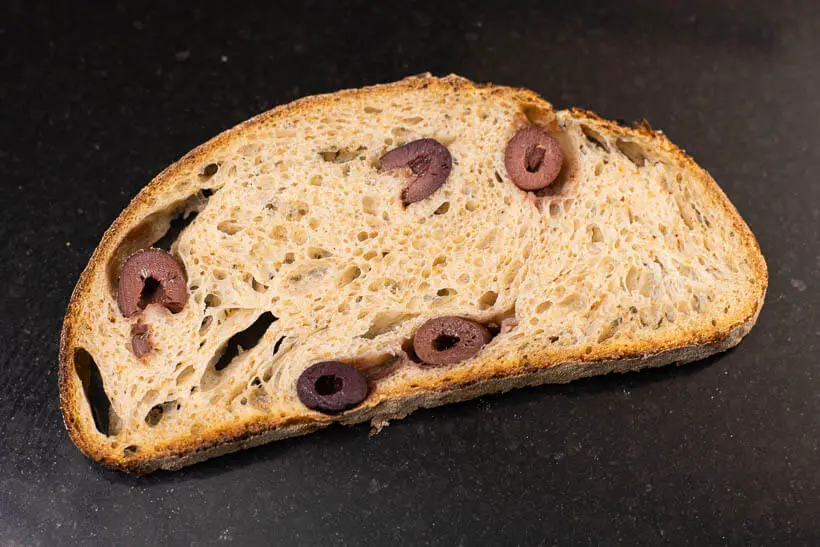
The crust is super crispy and has a fabulous smell. This is wonderful bread as a side for almost any Mediterranean dish and many dishes in middle eastern cuisine.
It’s a fabulous bread. I hope you’ll try to make it.
Please share on social media
This is my recipe for sourdough olive bread. I hope you will try to make it.
If you make it and post it on Instagram, please tag me as @foodgeek.dk so I can see what you made. That would make me very happy.
Ad links! The links for equipment and ingredients in this recipe are affiliate links, which means I will receive a commission if you purchase the product.
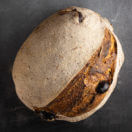
Sourdough Olive Bread
Ingredients
The dough
- 704 g bread flour
- 159 g whole wheat flour
- 250 g sourdough starter fed and grown to its peak
- 616 g water
- 21 g salt
Extras
- 250 g kalamata olives
- 2 teaspoon dried basil
- 1 teaspoon dried thyme
- 1 teaspoon dried oregano
- 1 teaspoon dried rosemary
Instructions
Mix the dough
- Mix everything for the dough into a shaggy dough. Cover it, and leave it to develop the gluten for one hour.
Bulk fermentation
- At the beginning of the bulk fermentation, you should do three sets of stretch and folds every 30 minutes.
- Do a set the following way:
- Wet your hands. Grab the dough in the back of the dough, and stretch it upwards as far as it goes without breaking.
- Fold the dough down towards yourself. Turn the bowl a quarter turn and repeat.
- Do two more so that you've stretched and folded the dough from all four sides. During the second set of stretch and fold, add ¼ of the olives before doing the stretch and fold.
- Then add a quarter more of the olives for each stretch and fold until you've added all of the olives to the dough.
- After the last stretch and fold, do a windowpane test to see if the gluten development is good. If not, add one more set and then move on.
- Leave the dough covered by a damp dishtowel for 3-4 hours until it's grown 30-40%.
Dividing & pre-shaping
- Pour the dough onto your unfloured kitchen counter and divide it into two using your bench scraper. I usually weigh the dough, but you don't have to.
- Take one piece of dough and flip it over. We are going to work some strength into the surface of the dough.
- Grab the bottom of the dough (closest to you), stretch it up, and fold it halfway over the dough.
- Continue with the right side, the left side, and the top of the dough. It should resemble an envelope.
- Flip the dough over so that the part against the table is now facing up.
- Put your bench scraper behind the dough and pull it forward so that the top of the dough is drawn in under the front of the dough, thus tightening the top.
- If an olive pops out of the dough, don't push it in. Either remove it entirely or add it to the back of the dough.
- Put the scraper in the front of the dough and push forward and turn the dough so that the scraper is behind again.
- Keep going until the dough is a pretty nice ball.
- Leave both dough pieces to rest for about 20 minutes to relax the gluten.
Shaping the dough
- Flour two oval bannetons
- Put a little bit of flour on your kitchen counter. Flip a piece of the dough onto the flour.
- Put it out into a rectangle. Stretch one side out and fold it over the dough. Repeat with the other side.
- Roll the dough up tightly. Roll the seam downwards toward the table.
- Seal the ends by pulling the dough on the side down over the roll on the side
- Put the shaped bread in an oval banneton with the seam upwards and put it in a plastic bag so that the dough doesn't dry out.
- Shape the other bread.
Final proof
- Then you need to do the final proof. You can choose to bake the same day and let the dough proof on the kitchen counter, or you can put it in the fridge and do an overnight proof.
- If you let it proof on the counter, you can check if the dough is ready to bake using the poke test.
- Poke the dough lightly with your index finger. If the hole fills in quickly it needs to proof more, if the hole fills slowly and leaves a slight indentation it is ready. If the hole doesn't fill the bread is over-proofed. Bake immediately.
Baking
- Put a dutch oven or combo cooker in the oven and heat your oven to 230°C/450°F/Gas mark 8. Let it heat for half an hour.
- If you opt not to use a dutch oven or combo cooker, you must steam the bread using other methods. If you bake steamed, you should use a baking stone or steel, and you can bake both loaves simultaneously.
- Bake covered (or with steam) for 20 minutes. Remove the lid or vent the steam.
- Bake for another 25 minutes until the bread is crusty, crunchy, and has a dark caramelized crust. If the bread does not look done once the 25 minutes are up, use your baker's intuition and keep it in until it's done.
- Bake the other bread the same way.



